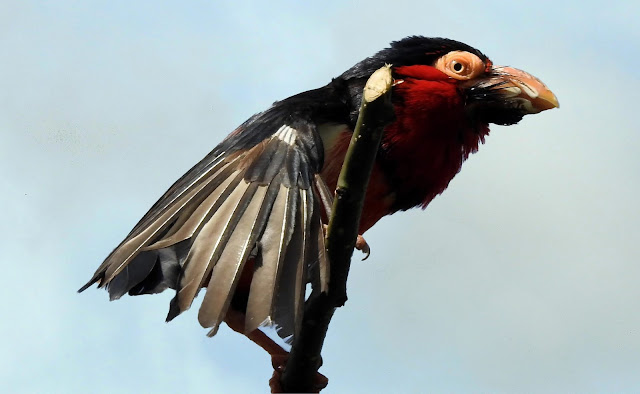This Blog contains Wildlife and Bird Photos from Walks, Safaris, Birding Trips and Vacations. Most of the pictures have been taken with my Nikon P900 and P950X cameras. On the right of the page are labels for each species of Bird/Animal etc. Click on a label to show all of the photos taken for that species. Information for each species is from Wikipedia. Just click on any image for a large picture.
TOTAL PAGEVIEWS
TRANSLATE
Wednesday, 31 March 2021
29-3-2021 BIOPARC, VALENCIA - FOREST SITATUNGA (Tragelaphus spekii ssp. gratus)
Social organization: Sitatunga are semi-social, non territorial, and sedentary. Swamps are highly productive ecosystems and sitatunga's can live at densities of 55/km^(2) or higher. Females tend to form herds and males associate together or with females until sub adult. As adults, males avoid one another.
Activity: Sitatunga's move through the swamp along established pathways. These have numerous side branches leading to feeding grounds and neighbouring riverine forest. They are active both diurnally and nocturnally and may move into marshy land at night. They typically feed at any hour in areas where they are protected. They also lie on platforms of vegetation that each animal prepares for itself by repeated circling and trampling. They also stand and ruminate in the water.
Locomotion: Sitatunga's are slow and clumsy land runners, but their plunging run works well in water. Their broad and splayed hooves keep them from sinking in soft ground as deeply as other ungulates. They are usually slow and inconspicuous, and are good swimmers.
Vocal communication: Males often bark at night, sometimes as an alarm signal, or perhaps as a way of announcing their location. Females have a single higher-pitched bark. A male following a female in a low stretch may utter a suppressed roar. (Estes, 1991)
Alchornea cordifolia, common around Lake Victoria, provides a favourite browse for sitatunga. Foraging takes place in both dry land and swamp. Sitatunga select plants in the flowering stage. They often emerge at night from swamplands to graze on nearby dry land, as well as in adjacent forests where they browse on foliage and creepers. Feeding activity is apt to be concentrated in a small area of swamp for many days at a time, then they suddenly shift to new grounds. Sitatunga feed while immersed up to their shoulders and move slowly through the vegetation. Sometimes forelegs may be immersed while hind legs are elevated. They may rear to reach flowers of tall reeds, sedges, grasses and foliage, and males have been known to break branches with their horns. When feeding on long leaves, a sitatunga wraps its tongue around a clump, pulls it into its mouth, and crops it with its incisors.
Tuesday, 30 March 2021
Subscribe to:
Posts (Atom)

















































